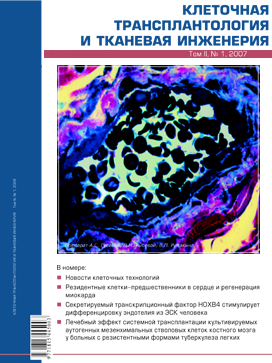Mesangioblasts transplantation - a new approach to cellular therapy of myodegenerative disease
- Authors: Grigoryan A.S.
- Issue: Vol 2, No 1 (2007)
- Pages: 14-15
- Section: Cell technology
- Submitted: 03.02.2023
- Accepted: 03.02.2023
- Published: 15.03.2007
- URL: https://genescells.ru/2313-1829/article/view/181652
- ID: 181652
Cite item
Full Text
About the authors
A. S. Grigoryan
Author for correspondence.
Email: redaktor@celltranspl.ru
Russian Federation
References
- Emery A.E. The muscular dystrophies. Lancet 2002; 359: 687-95.
- Dell’Agnola C., Wang Z., Storb R. et al. Hematopoietic stem cell transplantation does not restore dystrophin expression in Duchenne muscular dystrophy dogs. Blood 2004; 104(13): 4311-8.
- Qu-Petersen Z., Deasy B., Jankowski R. et al. Identification of a novel population of muscle stem cells in mice: potential for muscle regeneration. J. Cell Biol. 2002; 157: 851-64.
- Minasi M.G., Riminucci M., De Angelis L. et al. The meso-angioblast: a multipotent, self-renewing cell that originates from the dorsal aorta and differentiates into most mesodermal tissues. Dev. 2002; 1 29: 2773-83.
- Galvez B.G., Sampaolesi M., Brunelli S. et al. Complete repair of dystrophic skeletal muscle by mesoangioblasts with enhanced migration ability. J. Cell Biol. 2006; 174: 231-43.
- Bachrach E., Li S., Perez A.L. et al. Systemic delivery of human microdystrophin to regenerating mouse dystrophic muscle by muscle progenitor cells. Proc. Natl. Acad. Sci. USA 2004; 101: 3581 -6.
- Cossu G, Sampaolesi M. New therapies for muscular dystrophy: cautious optimism. Trends Mol. Med. 2004; 10: 516-20.
Supplementary files










